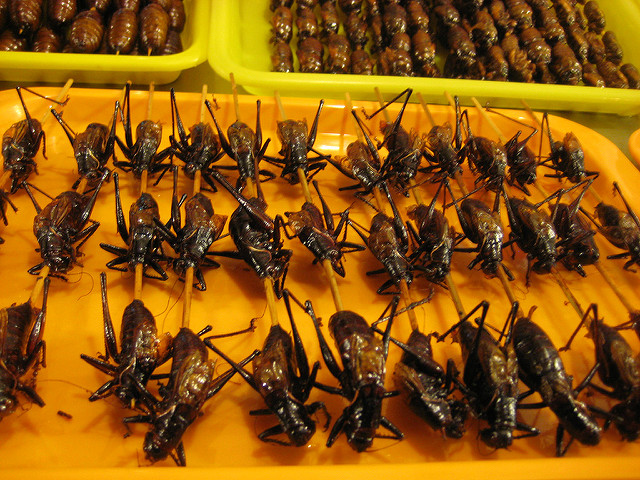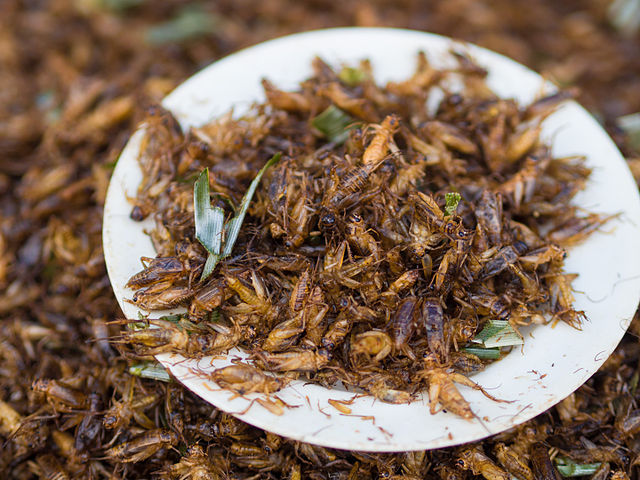This is the second and final part of a Q&A with Matt Grant and Matt Hardy – Co-founders of Newtri Foods. Newtri Foods aims to be one of the first companies in the UK dedicated to the farming of crickets and the creation of cricket-based products (flour, protein bars and whole crickets) exclusively for human consumption. [Click here to check out Part 1 of the cricket farming Q&A.]
Is farming crickets and making flour an energy efficient and environmentally friendly process?
There are many eco-friendly benefits to farming crickets for protein over current practices. We have listed a couple below which compare cricket and cattle farming:
- Crickets emit 80 times less CO2 and require significantly less water than cattle rearing.
- Farming Crickets takes 95% less land space than rearing cattle on farmland that is shrinking every day.
- We hope to one day use solar power to heat our warehouse to reduce our environmental impact even further.
Has it been difficult to get started? Are the regulations for this burgeoning industry easy to navigate?
The process to get started can be lengthy due to the natural breeding and raising process of crickets and there are also health & safety guidelines and practices that need to be put in place like any other food manufacturer. There are a many online documents that make the regulation side a lot easier to navigate and get your head around.
Are there any incentives to get involved in edible insect farming?
There is currently no government support that we are aware of however we have had support from our local growth hub in Northampton. We are potentially looking at launching a KickStarter campaign to raise some extra funds to get our products out to the UK market quicker so everyone can enjoy the benefits of eating cricket-based products.
Who are your target clientele?
We have no set clientele and hope that our products will appeal to all those who are initially a little bit curious and adventurous but also willing to try an alternative, healthy protein source that comes with many other health benefits as well. We think there could be high interest within the sports and fitness market segment as their openness to new products with high protein content is high. Our products are gluten, soy and dairy free so we hope to be able to target a wide audience. People who love baking and want to make goodies that are a little healthier will also love our products.

We use cricket flour to make tasty brownies.
How are you going to convince people that cricket flour is for them?
That is the million dollar question, the western world is not familiar with eating insects at present but we believe the tide is slowly turning. The US and Canada have several farms now and have reported great successes with many happy and healthy cricket-eaters. We believe the same can be done with the UK market and have already had interest from a local gym network as well as catering companies throughout the UK. Market research will of course remain a key tool to continuously work on product placement and branding to encourage uptake.
It took a many years to persuade the UK public to try sushi, but when they did the outcome was fantastic and now it is one of the most popular types of food that exists. We believe that one day insect-based foods can do the same!
Where will you sell your products?
We aim to market our products both online and in affiliated stores. Our interested clients operate across both platforms. We will also take our products to local and national markets and fairs to help promote awareness and get as many people to taste our products as possible.
What’s your favourite thing about cricket farming?
We both love that we are helping to develop a new frontier in both nutrition and sustainability of our planet. The health benefits that we have already seen through using cricket products are also something that continues to drive us. Although still in our early stages, we hope to one day be one of the key drivers of this industry as it grows and grows. Another great thing is the beautiful chirping sound they make. It may be pouring with rain outside, but in the warehouse with the warmth it feels like you’re sat on a beach in the Mediterranean… just without the sun, sand and cocktail in hand!
What’s your biggest frustration?
I would say there are no big frustrations (at the moment!) but as farmers of living creatures the process of raising crickets can often be timely and therefore a patient mindset is definitely necessary.
How would you describe the current state of edible insect farming in the UK?
It is very much in its early days. There are a few companies trying to explore and develop this industry in the UK that I know of. I have heard of more starting recently, so hopefully the industry will start to develop more rapidly and more cricket products will be available to the public in the near future. Interest in cricket products is definitely picking up though. We’ve recently had an enquiry from a company that wants to use our crickets in their canapés! Yum!
When it comes to edible insects, what is your vision for the future?
We believe that there is huge potential for the edible insect industry in the future, not only globally but in the UK as well. Every year there is more and more pressure being placed on traditional livestock and protein sources, and we believe that one day demand will outstrip supply (or they will have to severely reduce the way livestock are kept to increase production, which we don’t want).
Insects are highly nutritious, not just in terms on protein but also in other nutrients such as iron, amino acids etc. They require a lot less water to raise, a lot less food, a lot less space and release less harmful gases into the atmosphere. In places like Africa, which still suffer from severe malnutrition, we believe that insects could be one of the ways to solve this problem due to the small quantities of resources needed to raise them and their nutrition values.
In places like the UK, which are more developed, we believe people need to be more aware of the environmental impact that our over-consumption of livestock is causing and be open to trying alternative protein sources which in their original form may look unappetising, but used as an ingredient in other forms can be delicious and add an extra health kick to their meals. Changing people’s opinions is always a difficult task, but we believe that once this happens the insects-as-a-food-source industry will flourish.
Please do write us a comment if you have any other questions that relate to cricket farming or edible insects and we’ll try and rustle up some answers.




